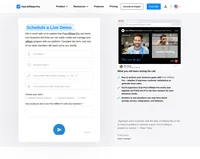What is geotargeting in affiliate marketing?
In the most general meaning, geotargeting is all about identifying a geographic location a website visitor comes from based on their IP address. This location data is usually represented as the country of origin or, more specifically, as a particular region and even a city. While geotargeting plays a key role in helping digital marketers maximize their marketing efforts, it can also be efficiently used in affiliate marketing. In fact, when it comes to affiliate marketing, geotargeting can benefit both sides, affiliate advertisers and affiliate publishers.
For instance, if your business currently operates in English speaking countries and wants to enter the Asian market, you may want to recruit relevant affiliates who will help you reach a larger base of potential customers on that market. Running your outreach campaign in English to attract Chinese speaking influences would not only make little sense, but can also be a waste of time and money. This is where geotargeting and customizing your paid ad campaigns based on geographic segmentation will increase your chances of engaging with the right affiliates.
On the other side, if you are a publisher who wants to promote an affiliate offer and attract prospects, geotargeting can help you optimize the efficiency of your campaigns. It will display your ads and affiliate links only to the relevant audience. Leaving out the locations where the audience wouldn’t be interested in your offer, or wouldn’t be able to understand the language of the promoted content will ultimately help you increase conversions and your affiliate commission revenue.

What is the purpose of geotargeting?
Geotargeting (also called geo targeted advertising) is an essential part of any digital advertising strategy because it helps marketers better reach their advertising goals. By creating more relevant, targeted ads and promotions it ensures that their advertising impressions reach actionable audiences. Advertisers can specify a particular geographic location (or a set of locations) they want their ads to be displayed at. Visitors can basically be targeted based on a continent, country, city, or even zip code and specific neighborhood.
By running a geotargeting advertising campaign, you can literally target the right area with the right content. More regionally understandable and relevant advertising translates to more actionable audiences. Geotargetted advertising efforts help ecommerce sites in gaining digital views and increasing advertising impressions. While brick-and-mortar stores, and other businesses heavily dependent on foot traffic, benefit from geotargeting by advertising to local prospects. Besides, it can also help determine which ads are more efficient in a particular area.
How can small business marketers implement geotargeting?
Recent developments in marketing and innovations in location based technologies have made geotargeting one of the most efficient ways for small businesses and advertising agencies to improve their marketing campaigns. Geotargeting has particularly proved to be highly beneficial to local small businesses, such as retail locations, restaurants and service providers.
For example, if you’re a real estate agency, you may want to target people in a specific area. Showing your banner ads to everyone, everywhere would mean a waste of your advertising budget. Here, geotargeting can ensure that your marketing campaigns are effective and cost-efficient because you can avoid wasted clicks from irrelevant audiences.
What is the difference between geotargeting and geofencing?
Geotargeting and geofencing are used to accomplish different objectives. Yet both are undoubtedly powerful strategies of location based marketing for running targeted advertising campaigns.
Geofencing is used to target all users (mostly mobile phone users) within a certain radius of a predefined point location. You set a virtual fence on a map around a specific location of your interest and whenever users cross that invisible boundary, they will see your ad in the mobile browser or mobile app, get a push notification or an SMS alert. With geofencing you can target particular zip codes, neighborhoods or even more specific physical locations.

Geotargeting, however, takes you one step further in location-based marketing. It can not only be set for a wider geographical location (cities, states, countries), it also allows you to add additional parameters in order to narrow down your target audience by demographics, interests and behaviors. This ensures your ads will be delivered only to users that meet your specified targeting criteria within your desired geographical area. Besides, with geotargeting you can exclude specific location targets. On the whole, both B2C and B2B companies can take advantage of geotargeting in their marketing initiatives and affiliate marketing strategies.
Geofencing vs. Geotargeting
| Geofencing | Geotargeting |
Allows setting virtual fences and target all users within that specific geographic location once they enter the fence. | Allows setting a wider geographic location and targeting a more specific audience based on demographics, interests and behaviors. |
To sum it up
Geotargeting is designed to help marketers improve their digital marketing strategies by targeting specific audiences with the relevant ads based on their actual or assumed geographic location. When done right, geotargeting can result in improved user engagement, increased traffic and better conversions. It ensures that you are not wasting clicks by displaying ads to users outside of your specified location.
Geotargeting has proven to be a highly efficient and cost-effective way for small businesses (like local service providers and retail shops) to improve their ad campaigns. By implementing geotargeting marketing campaigns, small business advertisers can ensure their ads are only served to potential customers within a specific location instead of being wasted on irrelevant clicks. This is one of the best tools to maximize ROI with a limited budget. And in the end, saving money is what matters most.
Frequently Asked Questions
What is geotargeting in affiliate marketing?
Geotargeting refers to the practice of delivering localized content to users based on their geographic location, and if often used by digital marketers to optimize their advertising efforts.
How can small businesses benefit from geotargeting?
By implementing geotargeting marketing campaigns, small business marketers can ensure their ads are only served to potential customers within a specific location instead of being wasted on irrelevant clicks.
Share this article
The leader in Affiliate software
Post Affiliate Pro offers a comprehensive affiliate software platform to manage multiple affiliate programs with ease. Enjoy no setup fees, 24/7 customer support, and a free 1-month trial. Ideal for small and large businesses, it features precise tracking, automated workflows, and customizable tools to boost your affiliate marketing success. Try it now and streamline your affiliate operations effortlessly!
Effortlessly integrate your e-commerce site with Post Affiliate Pro and boost your affiliate program's success. Our expert team ensures seamless integration with your payment processor, handling technical issues along the way. Enjoy a free trial and free integration service, saving you time and maximizing your ROI. Join now and experience top-notch affiliate management with over 500 integration options.
A guide to different types of affiliate tracking
Explore the comprehensive guide on affiliate tracking methods like cookie, postback URL, and IP tracking to optimize your affiliate marketing strategy. Learn how Post Affiliate Pro's advanced software ensures precise tracking, maximizes sales, and provides exceptional support for seamless affiliate cooperation. Unlock your brand's potential with cutting-edge tracking solutions today!













